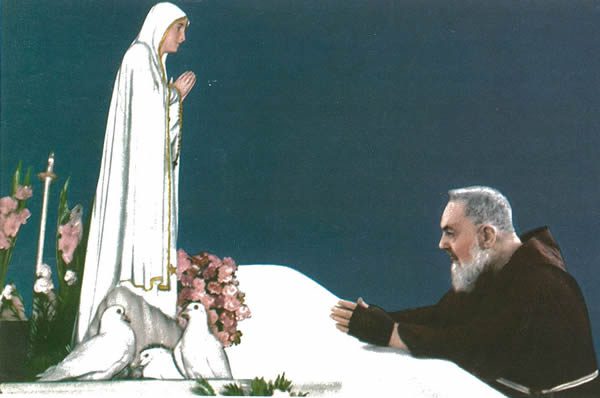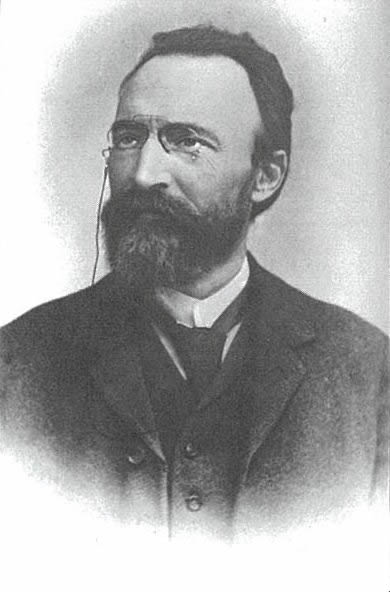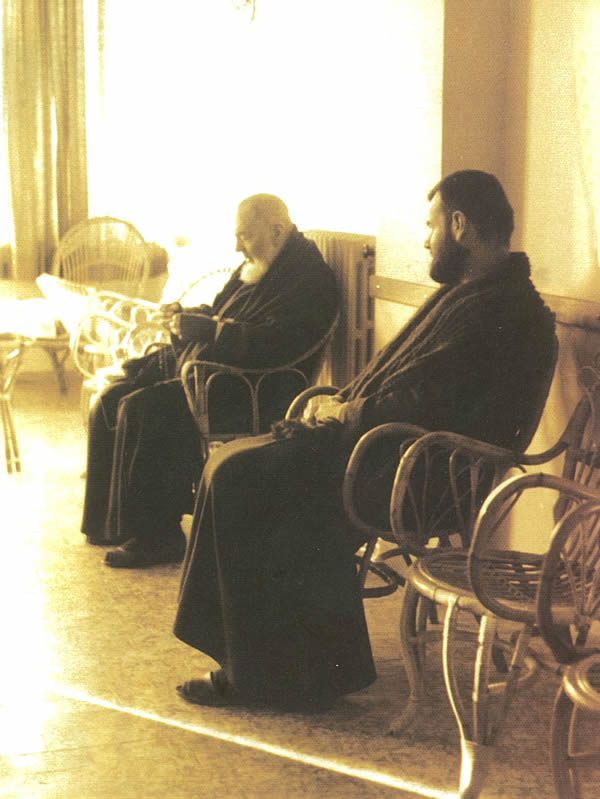Padre Pio’s Love for the Blessed Virgin Mary – Part 2
May Jesus always be the pilot of the little boat of your spirit. May Mary be the star which lights the path for you and shows you the surest way to reach the Heavenly Father.
– St. Pio of Pietrelcina

Padre Pio’s love for prayer embraced his whole life. When someone inquired how he was able to pray so many rosaries each day, he answered, ‘The Lord asks this of me. He does not ask the same of you.’ Once when he was ill, he confided to his superior, ‘What made me suffer the most was not being able to say even one Hail Mary.”
At the end of each day, Padre Pio and his fellow Capuchins gathered together in the church for evening prayers. After the Rosary, they would pray St. Alphonsus de Ligouri’s prayer, the ‘Visit to Jesus in the Blessed Sacrament’ and the ‘Visit to Our Blessed Lady.’ Often Padre Pio’s voice was broken by sobs as he recited the beautiful prayers to Jesus and Mary. The Novena to the Sacred Heart of Jesus followed and was prayed for the intentions of all who had requested prayers. After the evening prayers, the members of the Capuchin community went to dinner in the refectory. Padre Pio, who had only one meal a day, at noontime, remained in the church to pray.
When Padre Pio finally retired to his cell at night, one or two of the Capuchins would usually stop by to bid him goodnight. They would always recite a Hail Mary together before parting. Padre Pio kept a Rosary on the table by his bed and one under his pillow, always close by and ready for use.
One evening Father Carmelo stopped to visit Padre Pio in his cell. Padre Pio told Father Carmelo that he was going to say several more rosaries and then go to bed. ‘How many rosaries have you said today?’ Father Carmelo asked. Because Father Carmelo was his superior, Padre Pio felt obliged to answer. ‘I have prayed thirty-four rosaries today,’ Padre Pio said.
Padre Pio’s favorite month was the month of May because it is the month that is traditionally dedicated to Mary. How fitting that Padre Pio was born on May 25, during the month when Mary is honored throughout the Church. He used to say that May was the most beautiful month of all because it brings to mind, ‘the tenderness and beauty of Mary.’ In a letter to Padre Agostino, Padre Pio wrote:For me, the month of May is a month of graces . . . Poor dear Mother, how you love me! I observed it once more at the dawn of this beautiful month. What great care she took to accompany me to the altar this morning. It seemed to me that she had nothing else to think about but myself as she filled my whole heart with sentiments of holy love. (Letters I)
Padre Pio loved to say Mass at the altar of the Blessed Virgin Mary and the Mass of the Immaculate Conception was the Mass that he celebrated most frequently. To a spiritual daughter who asked him for a thought on the Madonna, he said, ‘My daughter, it is enough for you to know that Mary is the Mother of Jesus . . . She loves us so much that she offered to God the Father, his only natural Son to save his adopted sons . . . She is a great and inestimable treasure who encloses in herself an infinite treasure, the Son of God.’
Padre Pio had a tender devotion to Our Lady of Pompeii and he prayed the novena to Our Lady of Pompeii throughout his life. A beautiful shrine that is dedicated to Our Lady of Pompeii is located in southern Italy, near the ancient city of Pompeii. The shrine was founded by the great friend of God, Blessed Bartolo Longo. After a dramatic conversion back to his faith, Bartolo became a Third Order Dominican and took the religious name Fratel Rosario (Brother Rosary) in honor of the Rosary. He dedicated the rest of his life to spreading devotion to the Virgin Mary.

Blessed Bartolo Longo, often called the Apostle of the Rosary, dedicated his life to spreading devotion to the Virgin Mary. Padre Pio had the highest esteem for him and corresponded with him.
On one occasion, Bartolo was given a painting of the Madonna. The painting was in very poor condition for through the years it had become stained and torn in places. Bartolo decided to have the painting refurbished. He wanted to build an altar in the parish church and place the painting of the Madonna on it. He requested permission from the bishop. The bishop told Bartolo that what was needed much more than an altar was a larger church. He asked for Bartolo’s help and he agreed to do whatever he could to assist the bishop. After much hard work, Bartolo completed the building project. He had the painting of the Madonna restored to its original beauty. Jewels were embedded into the painting as well as a crown which was placed on the Madonna. The image was put on a special altar in the new church.
Bartolo realized that there was something altogether unique about the painting, something which, as he said, ‘impressed the soul.’ And it was true. Visitors to the new shrine, upon seeing the image of Our Lady of the Rosary, knelt down and began to pray. The painting came to be known as the Madonna of Pompeii. Soon cures and favors were reported by those who prayed before the painting. One of the first reported miracles was the complete healing of Bartolo’s own mother, who had been on her deathbed. Bartolo decided to document the favors that were being received and it was not long before he had recorded more than 900 miracles. Bartolo also composed a novena to the Virgin of Pompeii which became widely circulated. As the word spread, more and more people had the desire to visit the shrine of Our Lady of the Most Holy Rosary in Pompeii and it became the destination of thousands.
Bartolo Longo was beatified on October 26, 1980 by Pope John Paul II, who called Bartolo the ‘Apostle of the Rosary.’ Pope John Paul II had made a visit to the shrine of Our Lady of the Most Holy Rosary in Pompeii one year before he declared Bartolo blessed. The Holy Father returned to the shrine in 2003 to pray for world peace. More than four million people visit the shrine each year.
Padre Pio made a number of pilgrimages to the shrine of Our Lady of the Most Holy Rosary in Pompeii. When he was fourteen years old, he traveled there with seven of his classmates and his teacher, Angelo Caccavo. He also made several visits to the shrine after his ordination to the priesthood. He had a great admiration for Bartolo Longo and on one occasion he sent him a holy card on which he inscribed on the back, ‘For Bartolo Longo – May Mary always look down on you with a maternal eye and comfort you in your afflictions.’ Bartolo once wrote a letter to Padre Pio asking for his advice on a personal matter and Padre Pio wrote back to him, offering his spiritual counsel.
Throughout his life, Padre Pio made countless novenas to Our Lady of Pompeii. When he needed a special grace for himself or for someone else, he would frequently ask people to pray to Our Lady of Pompeii for his intentions. He wrote to his spiritual daughter, Raffaelina Cerase, ‘I should like to ask you, if it is not inconvenient, to do me the kindness of making three consecutive novenas to the Virgin of Pompeii for a grace to be obtained for me from her Son, a grace which will mean a great deal for a certain soul.’ (Letters II)
Padre Pio also wrote to Paolo Bavassano, thanking him for his prayers to Our Lady of Pompeii. He wrote, ‘I thank you for the novenas you made for me to Our Lady and I would ask you, if it is not inconvenient, to continue, because I am in great need.’ (Letters IV)
It was the Virgin Mary who came to the aide of Padre Pio and assisted him in the many trials of his life, including the times when he was attacked and tormented by the devil. One night in 1964, the superior of the monastery was awakened by a terrible noise coming from Padre Pio’s cell. When he rushed to see what had happened, he found Padre Pio lying on the floor. He was bleeding from a gash on the right side of his face, above his eyebrow. His face was swollen and there were black circles under his eyes as though he had been punched. Bruises were observed on his shoulders. Underneath his head was a pillow. When the superior asked Padre Pio what had happened, he said that the devil had come in his cell and attacked him. The superior asked him who had put the pillow beneath his head and he replied, ‘The Madonna.’ She had taken it from his armchair and placed it under his head.
Padre Pio was unable to celebrate Mass for one week while recuperating from his injuries. The superior decided not to disclose the full facts of the story to the public. The people in San Giovanni Rotondo were told simply that Padre Pio was unable to say Mass because he had fallen out of bed and injured himself. Right before this assault, Padre Pio had been praying intently for a woman who was in great need. She was believed to have been a victim of diabolical possession.
Padre Pietro Tartaglia, who served as the Father Guardian of the monastery of Our Lady of Grace, left a beautiful reminiscence of Padre Pio. He wrote:
I can see him today as he appeared to me when I was a youngster. It was beautiful to see him there in the silence of his cell when we Capuchin aspirants went to him for confession. The dim light gave a mystical touch to his emaciated but radiant countenance. Near him was a photograph of his mother who had died a short time before, and a little statue of Our Lady. He spoke about her to us and taught us to love her. At a certain hour he used to walk in the friary garden, absorbed in his sufferings and his love while the beads slipped through the fingers of his wounded hands. And how full and ardent was his voice when he recited the Angelus with the others, in the garden, in the choir or at the window. Who could fail to be moved by the sight of him as he walked with painful steps toward the altar for evening devotions and in a voice breaking with emotion recited the Visit to Our Blessed Lady.
The Bishop of Foggia, Most Reverend Msgr. Paolo Carta shared a close friendship with Padre Pio and visited him on a number of occasions. One day he invited the Auxiliary Bishop of Pisa, Italy, Most Reverend Msgr. Antonio Angioni, to accompany him to San Giovanni Rotondo to see Padre Pio. He assured Msgr. Angioni that if he accepted the invitation, it would be an experience he would cherish for the rest of his life. Msgr. Angioni agreed to go.
When the two bishops arrived at the monastery, the evening devotions had already begun. The church was filled to capacity but they managed to find seats on the last bench, in the gallery of the church. Because they were sitting in the back, they were not able to see the Capuchin who was leading the evening prayers. However, they were able to hear him clearly. Bishop Paolo Carta said:
At the moment of our arrival, the priest was reciting the prayer to Our Blessed Lady. As I have said, we didn’t see him, but in the mystical silence of the little church, his voice reached us clearly and distinctly . . . That voice was so striking as he recited the prayer in vibrant and moving tones that it caused Msgr. Angioni to marvel. He turned to me and asked, ‘Who is reciting the prayer?’ to which I replied, ‘Padre Pio.’ How well Padre Pio prayed. One felt that he put his whole heart into it, his whole soul, his whole self . . . Msgr. Angioni, who is blessed with a delicate spiritual sensitivity, was at once aware of something exceptional, something extraordinary. It was the intense vibration of a soul filled with faith, the sweet outpouring of a heart full of love for Our Lady. Padre Pio pronounced each word very distinctly and in such tones as to touch the hearts of all present, even to the point of tears.
On another occasion, Bishop Carta visited Padre Pio’s monastery and brought a friend with him, an officer from the province of Cagliari, in Sardinia. Bishop Carta told Padre Pio that his friend wanted to ‘be assured of a ticket to Paradise.’ He asked him for his thoughts on the matter. Padre Pio said simply, ‘Here we need Our Lady, we need Our Lady.’
In April 1959, the Pilgrim Virgin statue of the Madonna was taken from the shrine in Fatima, Portugal to visit a number of the provincial capitals in Italy. Foggia, not a great distance from San Giovanni Rotondo, was one of the cities where the statue of the Madonna was going to stop. Bishop Carta, was very happy that the Pilgrim Virgin would be making a visit to his diocese and was preparing the citizens of Foggia for the time of her arrival.
Padre Pio had become ill with a serious case of pleurisy about the same time that the Pilgrim Virgin statue left Fatima. Because he had a great desire to see the image of the Madonna, a change was made in the schedule and San Giovanni Rotondo was added to the itinerary. Due to his illness, Padre Pio was unable to say Mass or hear confessions and was growing weaker by the day. He had to endure a number of painful procedures whereby the fluid was drained from his lungs. The superior of the monastery, alarmed at his condition, called in a number of specialists to examine him. Four doctors diagnosed Padre Pio as having a cancerous tumor on his lung but Padre Pio was not convinced of it. More than once he was admitted to the hospital, the Home for the Relief of Suffering, but he was always anxious to return to his religious community. He said that he did not want to die in the hospital. He wanted to die in the monastery.
Although incapacitated by his illness, Padre Pio was looking forward to the arrival of the statue of Our Lady of Fatima with great anticipation. Every evening from his sick bed, he spoke through a microphone to the faithful who were gathered outside. His brief but inspirational messages were received joyfully by his spiritual children. On July 12, during his evening address, he spoke of Mary and said, ‘Let us love always more this Mother and let us be confident that she shall not deny us anything because to her nothing is lacking and she has the heart of a Mother and a Queen.’
Padre Pio waited with great longing for the day of the Pilgrim Virgin’s visit. He said:
Our hearts are trembling for the arrival of this Mother. Why is she coming? Because she wants to visit her children. Therefore, it is an act of love. Therefore, let us prepare to empty our hearts of all that is neither of God, nor connects with God, nor leads to God. And this is the best welcome we can give to this celestial Mother. To keep something back is not worthy of a child in front of a Mother that is offering all of herself. This visit should not be limited to simple enthusiasm, but must remain permanent, as our Mother’s eye is permanently on us. Let us renew often the resolutions which we have made on this day of our celestial Mother’s visit.
On July 27, Padre Pio announced that the novena was beginning in preparation for the visit that the ‘Heavenly Mother wants to make.’ Each evening of the novena, Padre Pio spoke to the people of the ‘very special grace’ that would be coming to all with the arrival of the Pilgrim Virgin statue. He encouraged everyone to give thanks to God and to increase their prayers and devotions. On August 5, he announced, ‘In a few minutes our Mother will be in our house . . . Open your hearts.’
When the Pilgrim Virgin statue arrived in San Giovanni Rotondo, Padre Pio was in bed. He had been bedridden for more than three months. The statue was taken to the church of Our Lady of Grace. For this occasion, the church remained opened day and night. Padre Pio was brought to the sacristy in a wheelchair. He kissed the image and placed a gold Rosary in her hands. Because of his extreme weakness, he had to be taken immediately back to his bed.
Afterward, the Pilgrim Virgin image was taken through all of the wards of the Home for the Relief of Suffering. When the statue was leaving San Giovanni Rotondo, a huge crowd assembled in the square outside the church to bit her farewell. Padre Pio, too, wanted to view her departure so he was taken to the balcony of the church. As a farewell gesture to Padre Pio, the helicopter that was to carry the statue to Sicily, circled three times around the church before leaving.
As Padre Pio watched from the window, he was overcome with sadness and he began to cry. He prayed, ‘Dear Mother, when you came to Italy, I became sick. You have visited me here and I am in the same condition. Now you are leaving. Will you not give me your blessing and heal me?’ At that moment a sensation of warmth and a kind of shudder ran through his entire body. All at once he felt completely well and had the desire to walk and to exercise a bit. The next day he wanted to celebrate Mass but his superior did not think it was advisable. That evening a doctor examined him and declared that he was well and could celebrate Mass the following day and resume all of his normal activities.
After the Pilgrim Virgin statue left Italy, an article appeared in the newspaper voicing a complaint. Someone wrote that it would have been preferable if the Pilgrim Virgin had traveled to Monte Sant Angelo, to the well-known shrine dedicated to St. Michael the Archangel, rather than to San Giovanni Rotondo. When the article was brought to Padre Pio’s attention, he said simply, ‘Our Lady came here because she wanted to cure Padre Pio.’ He told many people about his miraculous healing through the intercession of Our Lady of Fatima. His eyes always filled with tears whenever he talked about it.
The pilgrims who came to Our Lady of Grace monastery, continually sought Padre Pio out, asking for his prayers. He encouraged the sick to pray and to have faith. He would often say, ‘Let us pray to Our Lady that she snatch this grace for you from the Heart of Jesus.’ Never strong physically, Padre Pio entrusted his own health concerns to the care of the Mother of God. He wrote that God had, ‘put the problem of my health and a victorious outcome into the hands of our heavenly Mother.’ When people came to Padre Pio, thanking him for his prayers and in many cases for the healings that were a direct result of his prayers, he would respond, ‘Do not thank me. I did nothing. Thank our Blessed Lady. It was she who healed you.’
On the one year anniversary of the Home for the Relief of Suffering, Padre Pio made a rare public speech. On that occasion, before a gathering of several thousand people, he prayed in thanksgiving for the hospital. He also invoked Mary’s intercession and prayed:
May Our Lady of Grace who is the Queen to whom every day and many times in the day we manifest our love, and of whom we ask her maternal assistance, reign always in the city that will rise here and may she assist all of you. May the Madonna intensify the love of her children for the Vicar of Christ on earth, and one day may she show us Jesus in the splendor of his glory.
William (Bill) Martin from Brooklyn, New York first met Padre Pio when he made a trip to San Giovanni Rotondo in 1959. Bill visited Padre Pio again in 1964 and when it was time to say goodbye, Bill found it very difficult to leave. As he was waiting for the bus to take him to Foggia, one of the members of the Capuchin community came running toward him and told him that Padre Pio wanted him to stay on at the monastery. Bill was overjoyed at the news. He became a Third Order Franciscan and was thereafter known to everyone as Brother Bill. After Padre Pio’s death, he was ordained to the priesthood and took the name Father Joseph Pius Martin.

Brother Bill Martin (Father Joseph Pius Martin) sitting on the veranda with Padre Pio sharing a quiet moment.
Brother Bill became Padre Pio’s personal assistant and worked close beside him on a daily basis. One afternoon, he and Padre Pio were sitting together on the veranda near Padre Pio’s cell. Enjoying the time of silence, each was occupied with his own thoughts. Brother Bill was thinking to himself what a great blessing it had been for him to have been able to have spent so much time close to Padre Pio. He knew how fortunate he was and he wondered who had obtained this wonderful grace for him. Was it Padre Pio or was it Our Lady who was responsible? Although Brother Bill had not shared his thoughts with Padre Pio, at the exact moment that he was thinking about it, Padre Pio turned to him and said, ‘It was Our Lady.’
On August 10, 1960, Padre Pio celebrated the fiftieth anniversary of his ordination to the priesthood. Between six and seven thousand people gathered in San Giovanni Rotondo to be present at his priestly Golden Jubilee. Included in that number were many of the doctors and administrators who served at the Home for the Relief of Suffering. Three bishops as well as the provincial superior of the Capuchin order assisted at the Mass. On that occasion, Padre Pio expressed his deep gratitude for his vocation to the priesthood. He also paid honor to his heavenly Mother. He prayed, ‘O Mary, most sweet Mother of priests, Mediatrix of all graces, from the depth of my heart I pray to you. I beg you, I implore you, to thank Jesus today, tomorrow and always for the inestimable gift of my fiftieth anniversary to the priesthood.’
Toward the end of Padre Pio’s life, the burdens of old age and ill health weighed on him. He suffered not only from the pain of the stigmata but also from exhaustion, weakness, severe headaches and many other physical ailments. Subject to asthma attacks, it was often difficult for him to breathe. In the last three years of his life, his fellow Capuchins noticed that he became more and more silent. When he had company, if the conversation of his visitors turned to small talk or idle chatter, he would quickly put a halt to it. When people approached him seeking his counsel, often, rather than speaking, he would simply hold up his Rosary, encouraging prayer as a solution to the trials and difficulties of life. In his last years, his greatest consolation was the Rosary, which he prayed night and day.
Just four days before his death, Padre Pio expressed his devotion to Mary in one of his final gestures of love. A man brought Padre Pio a beautiful bouquet of red roses for the occasion of the fiftieth anniversary of his stigmata. Padre Pio took one of the roses out of the bouquet and asked one of his spiritual sons who was going to Pompeii if he would take it to the shrine of Our Lady of the Holy Rosary. The man promised that he would take it there the very next day.
When the man arrived in Pompeii, he told a nun who served at the shrine that the rose had been sent by Padre Pio, who asked that it be placed before the image of Our Lady of the Rosary. Very pleased to receive the rose, the nun placed it in a vase with other roses. On September 23, the day that Padre Pio passed away, the nun noticed that all the other roses in the vase had withered but the one that Padre Pio had sent was still fresh and beautiful. The news of Padre Pio’s unfading rose reached the local bishop who decided to put it on display in a special glass container.
Padre Alberto D’Apolito, who had been very close to Padre Pio through the years, heard about the rose and wanted to see it. He took a number of Third Order Franciscans from San Giovanni Rotondo on pilgrimage to the shrine in Pompeii. They saw the rose that Padre Pio had sent to Our Lady of Pompeii and although the stem was slightly yellow in color, the rose remained fresh and intact. Their visit to see the rose occurred one year after Padre Pio’s death.
Cleonice Morcaldi, one of Padre Pio’s spiritual daughters, spoke to Padre Pio just a few days before his death. ‘Father, please give me at least one word,’ Cleonice said to him. He answered, ‘Love the Madonna and make her loved. Always recite her Rosary. That is the armor against the evils of the world today.’ ‘Is the Madonna close to you?’ Cleonice asked. ‘A Mother,’ Padre Pio replied. ‘All of Paradise is near her.’
Padre Pio’s love for Our Lady and for her Rosary supported and sustained him throughout his earthly pilgrimage. Father Domenico Mondrone spoke of Padre Pio’s love for Mary and said:
The Rosary was the most beautiful and longest sermon in honor of her, because it lasted the whole of his life. He spoke with the Rosary which he was seen to clutch always in his fingers, the Rosary he clutched in those last instants, almost as though it were the supreme link between the earth he was about to leave and the heavens which opened before him.
Padre Pio passed into eternal life very peacefully, very well prepared. He died with his Rosary in his hand. His last words were – Jesus, Mary.
Padre Pio Devotions Publications:
1. Pray, Hope and Don’t Worry: True Stories of Padre Pio Book 1
2. Pray, Hope and Don’t Worry: True Stories of Padre Pio Book II
3. Daily Reflection: 365 Reflections from the Saints and Other Holy Men and Women of God
4. They Walked with God Book 1: St. Bernadette Soubirous, St. John Vianney,
St. Damien of Molokai, St. André Bessette, Bl. Solanus Casey
5. They Walked with God Book 2: St. Teresa of Calcutta, St. Maximilian Maria Kolbe, St. John Bosco





